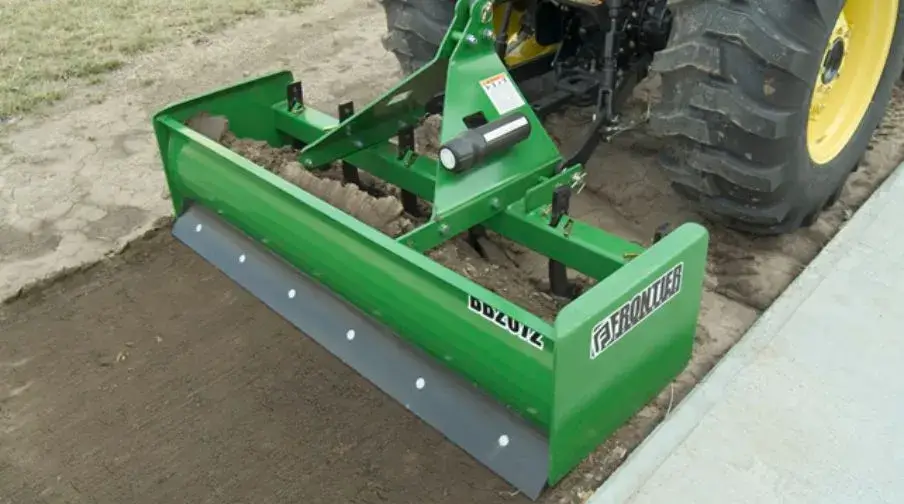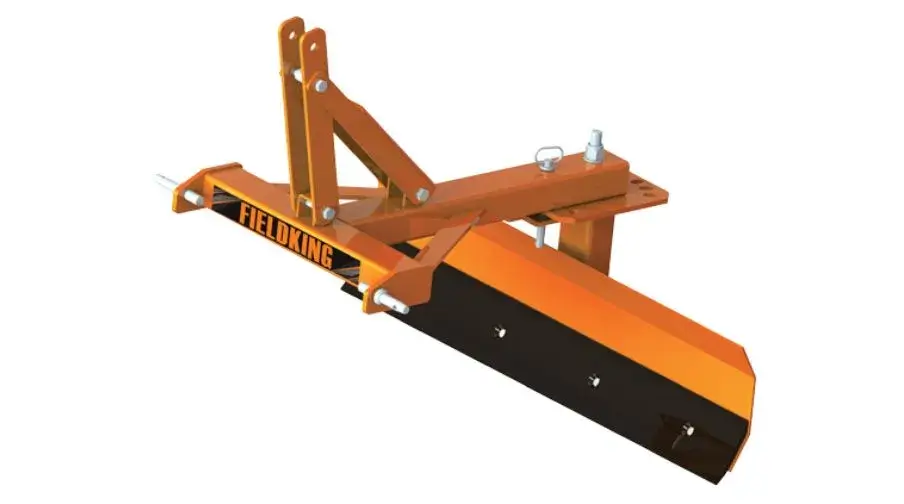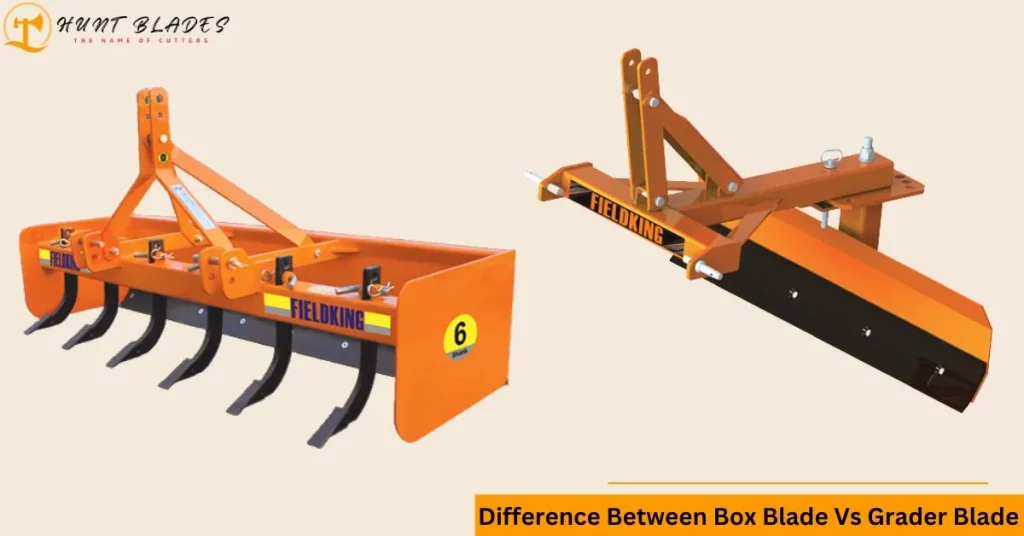Box blades and grader blades are both common tools used to level and grade land, but they are different in how they are made and what they do. A box blade looks like a box and has cutting edges, rippers, and scarifies. A grader blade, on the other hand, is straighter and has only one cutting edge. It is used to smooth out surfaces. In this article, we’ll look at how the two tools are different and help you decide which one is best for you.
What is a Box Blade?

A box blade is a versatile tool with a frame that looks like a box, teeth or ripper shanks at the front, a cutting edge in the middle, and a leveling blade at the back. The cutting edge is curved, which makes it easier to dig into the soil. The scarifiers and rippers can be used to break up hard soil or pull roots and other things out of the ground. The angle of the leveling blade can be changed, so you can grade the surface to the slope you want.
What is a Grader Blade?

A grader blade is a simple tool with a single straight blade that is used to smooth out surfaces. It is also called a land plane or a box scraper. It has a straighter shape than a box blade and doesn’t come with scarifiers or rippers. Grader blades come in different sizes and can be set at different angles, so you can make a flat surface with the slope you want.
Comparison of Box Blade vs Grader Blade
To help you decide between a box blade and a grader blade, let’s look at their features, how they’re used, their pros and cons, and what they’re good at and what they’re not so good at.
Weight and Size
Box blades are bigger and heavier than grader blades, so they are better for jobs that require a lot of work. The blades on graders are lighter and smaller, which makes them easier to move around and control.
Blade Shape and Angle
The cutting edge of a box blade is curved, which makes it easier to dig into the soil and break up hard ground. Grader blades have a straight blade that is meant to make surfaces even and smooth. Both blades can be turned to different angles, which lets you make the slope you want.
Cutting Edge and Teeth
Box blades have a cutting edge and teeth or ripper shanks that can be used to break up hard soil, remove roots, or get rid of trash.
Scarifiers and Rippers
There are scarifiers and rippers on box blades that can be used to break up hard soil or get rid of trash. Grader blades don’t have any rippers or scarifiers, and they are mostly used to make surfaces smooth.
Leveling Blade and Tilt Adjustment
Both box blades and grader blades have a leveling blade on the back that can be moved to different angles. Box blades also have a feature that lets you tilt the blade up or down to get the slope you want.
Uses of Box Blades and Grader Blades
Box blades and grader blades are both used to level and grade land, but they do so in different ways.
Box Blade Uses
- learning and leveling construction sites
- Preparing land for agriculture
- Maintaining driveways and gravel roads
- Removing debris and rocks
- Creating drainage ditches
- Building and maintaining firebreaks
Grader Blade Uses
- Smoothing out driveways and dirt roads
- Leveling out areas for construction or landscaping
- Spreading out soil or gravel
- Removing snow or debris from roads
Advantages of Box Blades and Grader Blades
Advantages of Box Blades
- Versatile and can be used for a variety of applications
- Comes with scarifiers and rippers for breaking up hard soil or removing debris
- Has a tilt adjustment feature for creating the desired slope
- Can be used for grading and leveling large areas quickly and efficiently
Advantages of Grader Blades
- Simple design and easy to use
- Can be adjusted to different angles to create a level surface with the desired slope
- Lighter and more maneuverable than box blades
- Ideal for smaller jobs or areas that require precision leveling
Disadvantages of Box Blades and Grader Blades
Disadvantages of Box Blades
- Heavier and larger than grader blades, making them more difficult to maneuver
- Scarifiers and rippers can be prone to wear and tear
- The tilt adjustment feature can be difficult to master for inexperienced operators
- May not be suitable for small or precise jobs
Disadvantages of Grader Blades
- Simple design may not be suitable for heavy-duty jobs
- Lack of scarifiers or rippers may limit its usefulness in certain applications
- The smaller size may require more time to complete larger jobs
- Straight blade design may not be effective in breaking up hard soil or debris
Which One to Choose? Box Blade vs Grader Blade
Whether you use a box blade or a grader blade depends on your needs and what you want to do. If you need a tool that can do a lot of different things and is strong enough for tough jobs, a box blade might be the best choice. A grader blade may be a better choice if you need a more maneuverable tool for smaller jobs that need to be leveled with precision. When making your choice, think about your budget, the size of the job, and the terrain you’ll be working on.
Conclusion
In conclusion, both box blades and grader blades are useful tools for leveling and grading land, but they are made differently and are used in different ways. Knowing how the two tools are different can help you choose the right one for your needs. Whether you choose a box blade or a grader blade, use it safely and follow the instructions from the manufacturer for the best results.
Frequently Asked Questions
Can I use a box blade or a grader blade on asphalt surfaces?
Box blades and grader blades are mostly made to be used on unpaved surfaces like dirt, gravel, or soil. If you use them on asphalt, you might hurt the equipment or the surface. To avoid expensive damage, it’s important to use the right tool for the job.
How do I maintain my box blade or grader blade?
To keep your box blade or grader blade in good shape, you should clean it and clear it of any dirt or other debris after each use. Check for signs of wear or damage and quickly replace any parts that are worn or broken. Lubricate all moving parts often to make sure everything works smoothly.
Can I use a box blade or a grader blade for digging trenches?
Even though box blades and grader blades are made for leveling and grading land, they might not be good for digging trenches. You might want to use a specialized trencher or a backhoe attachment to dig trenches.
Can I attach a box blade or a grader blade to any type of equipment?
Box blades and grader blades are usually made to fit on certain kinds of machines, like tractors, skid steers, or backhoes. It’s important to make sure that the blade you want to use works with the tools you have.
How do I know if I need a box blade or a grader blade for my job?
Whether you use a box blade or a grader blade depends on what your job needs. If you need to grade and level a large area with a lot of force, a box blade may be the better choice. If you have a small job that needs precise leveling, a grader blade might be a better choice. When making your choice, think about the size of the job, the terrain you’ll be working on, and your budget.
Shami Barber is a multi-talented professional, excelling both as a skilled barber and a part-time expert content writer. With a passion for creativity and a keen eye for detail, shami has made a name for himself in both industries, offering unique perspectives and exceptional craftsmanship.

